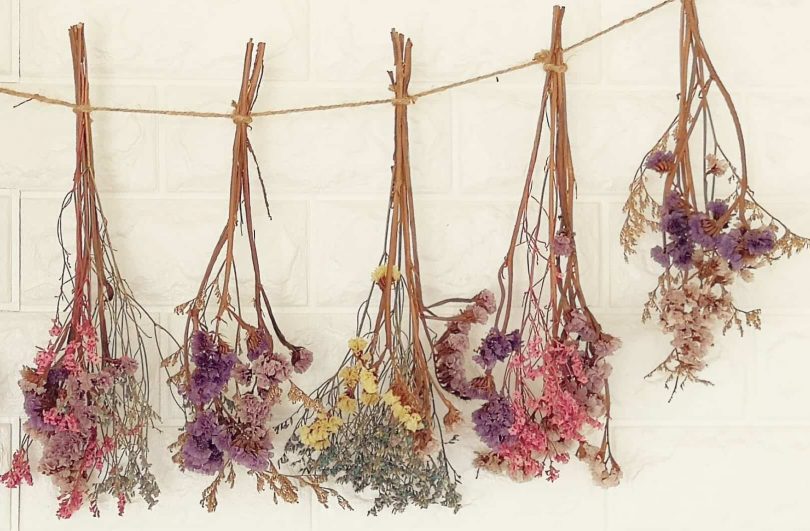Learn how to dry flowers at home.
Did you know that the art of drying flowers for the purpose of preservation has been done since ancient times? These days, most people do it to create beautiful and lasting decorations, as well as to cherish keepsakes such as bouquets.
The process might seem straightforward, but it is important to understand that not all flowers dry well. While you have plenty of beautiful blooms to choose from, so make sure you pick wisely.
SEE ALSO: 6 Easy Methods of Drying Flower Petals
The Best Flowers for Drying
Ranunculus
Despite being quite a delicate bloom, the ranunculus doesn’t wilt once it dries. You’ll find that its color does turn into a lighter shade, but the petals surrounding the center will stay intact and upright.
Yarrow
Yarrows are known to be a medicinal plant, but its flowers are certainly worth keeping around for a long time. The blooms dry beautifully and because it has sturdy stems, it’s also one of the most ideal ones to dry.
Statice
If you want blooms that doesn’t require much work when it comes to drying, look no further than the lovely statice. The straw-like flowers will stay intact and the deeply colored ones are likely to retain their vibrant hue as well.
Hydrangea
People might think that these blooms are too “top heavy” to dry, but this couldn’t be further from the truth. They are a classic specimen for dried flowers and keeps their shape, as well as their color.
French lavender
Another classic favorite when it comes to drying flowers, Lavender not only retains its beauty—you also get to enjoy its calming scent throughout the year. They’re easy to dry and can also be used in a variety of different ways after the fact.
SEE ALSO: 5 Easy Methods of Drying Lavender at Home
Calendula
Not only are these flowers loaded with skin-healing properties, but they are also quite easy to dry. Their yellow color does mute a bit after the process is done, but they do maintain their scent. You can even use it for other crafts such as soap making.
Cotton flower
Though unusual, these create a wonderfully rustic display once it’s been dried. You can pair it with other filler flowers such as baby’s breath and statice to create a stunning dried flower bouquet. These dry pretty quickly too!
How to Dry Flowers at Home
Harvesting flowers for drying
When it comes to harvesting the flowers you plan on drying, the best time to do so is during the late morning. This is when the dew has already evaporated from the leaves and the plant is relatively dry.
The best flowers to cut are ones with not fully-opened buds. Keep in mind that the flower will continue to open even after it has been cut, so choose accordingly. Some fully open flowers will lose their petals as they dry. This depends on the variety, but if you want to be sure, go for ones that are still in semi-buds.
Steps to keep in mind:
- Include about 6 or more inches of the stem when you cut. This would allow you to easily hang up the flowers when you’re drying them. You can always cut them shorter later on.
- Always check for any signs of wilting of insect damage.
- Make sure you use a sharp cutting tool to prevent damage to the live plant.
Materials for drying flowers:
- Sharp scissors
- Pieces of twine, ribbons, or anything you can use to tie up the flowers without damaging the stems
- Clothes drying rack or clothespins
Air drying flowers
This is the simplest method when it comes to preserving your cut flowers. For most crafters or hobbyist, this is also the most accessible method for drying flowers as you don’t need a lot to get it done.
- Start by gathering the flower stems in small bunches. Tie them together with your twine or a rubber band. Make sure it is tight as the stems will eventually shrink as they lose their moisture content.
- Once done, hang it upside down on your clothes rack. You can also hang up a length of twine (the same way you would tie up a laundry line) and use paper clips to hook each of your flower bunches onto it.
- If you’re only drying the heads of the flowers, cut off the stem and lay each flower head on a tray, screen, or weighted piece of paper.
- Keep these out of direct sunlight since exposure will bleach out their color.
Air drying usually takes about one week or more, depending on the humidity and weather in your location.
Drying flowers in a microwave
If you want to hasten the process, you do have the option of using a microwave to get the job done. However, this only works for smaller flowers and flower heads and requires constant monitoring. Drying flowers in a microwave is something I do not recommend.
- Take your flowers and flower heads. Place these in a microwave-safe container.
- Leave it inside for about 1 minute, check the dryness. If needed repeat for another 1 minute.
- Make sure to allow the container to cool for twenty or so minutes before you open it.
There might be instances wherein the flowers still feel moist to the touch. If this is the case, repeat the process.
Here is a nice video about drying flowers in a microwave:
Drying flowers using silica gel
What if you don’t have enough space in your home to dry out flower heads? If this is the case, you can use silica gel and an air-tight container to get the job done. Note that silica gel can be found in any craft store at an affordable price. It is also reusable. Just be sure to keep it away from children and pets!
- Find a container that’s wide and shallow enough to hold the flower heads. Next, spread about an inch of the silica gel at the bottom.
- Arrange the flower heads neatly. Once done, cover them again with another inch of silica.
- Seal this container tightly and keep it away from light.
The drying process should take about three to five days. Check after the first five days are done. If it’s still a little moist, simply replace the cover and wait another couple of days.
The best flowers to use with silica gel are pansies, anemones, zinnias, and daisies.
Here is a nice video explaining ho to dry flowers in silica gel.
SEE ALSO: 5 Easy Ways of Drying Rose Petals





